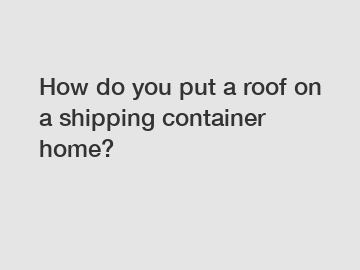How do you put a roof on a shipping container home?
WZHGROUP Product Page
How do you put a roof on a shipping container home?
Shipping container homes have gained popularity in recent years, thanks to their affordability, durability, and sustainability. These repurposed steel boxes offer a unique and stylish alternative for anyone considering a minimalistic lifestyle or looking for a cost-effective housing option. One crucial aspect of building a shipping container home is putting a roof on it. In this article, we will discuss various methods and considerations for putting a roof on a shipping container home.

1. Flat Roof:
- A flat roof is a popular choice for shipping container homes as it allows for easier installation and offers additional space for rooftop amenities like gardens or solar panels.
- To install a flat roof, ensure the container's top surface is clean and free from any rust or debris. Applying a layer of elastomeric paint or a rubberized membrane can help protect the roof from water damage.
- Proper insulation is crucial for maintaining temperature control inside the container. Consider using spray foam insulation to prevent heat loss or gain.
- To ensure water drainage, create a slight slope on the roof towards one end or install scupper drains for effective water runoff.
.
2. Pitched Roof:
- A pitched or sloped roof can enhance the aesthetics of a shipping container home and provide more interior headroom.
- Constructing a pitched roof involves attaching a steel or wooden frame to the container, which supports the roof structure.
- Choose roofing materials that are lightweight yet durable, such as metal sheets or shingles, to prevent excessive weight on the container.
- Make sure to consult with a structural engineer to ensure the added weight from the pitched roof does not compromise the integrity of the container home.
3. Green Roof:
- Green roofs have become increasingly popular due to their environmental benefits, energy efficiency, and aesthetic appeal.
- Green roofs consist of a waterproofing layer, root barrier, drainage system, and a layer of soil or growing medium where vegetation can thrive.
- Before constructing a green roof on a shipping container home, assess the structural capacity of the container to bear the additional weight of the soil and plants.
- Choose lightweight plants suitable for the climate, and consider using soil-less growing mediums to reduce overall weight.
- Green roofs offer insulation properties and can contribute to temperature regulation within the container.
4. Combination Roof:
- Combining different roof types can provide a unique architectural design while maximizing functionality.
- Consider combining a flat roof section with a pitched roof, allowing for a versatile and visually appealing shipping container home.
- Incorporating skylights or solar tubes in the pitch roof section can maximize natural light, reducing the need for artificial lighting during the day.
.
In conclusion, putting a roof on a shipping container home requires careful consideration of various factors such as functionality, aesthetics, insulation, and structural integrity. Whether you opt for a flat roof, pitched roof, green roof, or a combination of these, it is crucial to consult with professionals to ensure a successful and safe roof installation. Remember to prioritize weatherproofing, insulation, and proper drainage when constructing the roof, as they contribute significantly to the durability and livability of your shipping container home. So, how do you put a roof on a shipping container home? Explore the different options, assess your needs, and create a space that reflects your unique style and eco-conscious lifestyle.
You can find more information on our web, so please take a look.
Contact us to discuss your requirements of Light Steel Multi-function Room. Our experienced sales team can help you identify the options that best suit your needs.



